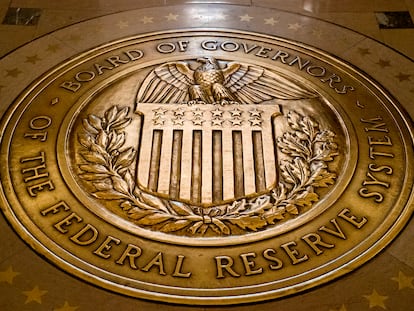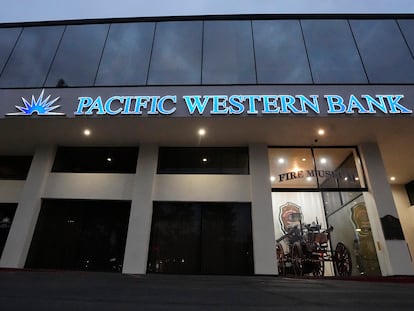Twitter whipped up financial panic and fueled SVB failure, researchers say
A study by academics in the U.S., France and Spain has found that Silicon Valley Bank’s collapse was preceded by a spike in social media chatter

The crisis that has shaken the U.S. banking sector since March has left several victims in its wake, and served up a powerful warning. In a matter of days, a financial institution can go from operating normally to being hit by a bank run that leaves authorities scrambling for a rescue package. This is what happened to Silicon Valley Bank (SVB). With a business model focused on tech start-ups, 96% of the bank’s deposits were above the $250,000 limit which, in theory, the Federal Deposit Insurance Corporation’s (FDIC) Deposit Insurance Fund would cover. As fears grew, people could not know that the FDIC would in fact protect all depositors, regardless of their balance, in a bid to avoid a potential contagion whose effects on the economy could not be predicted. The uncertainty that surrounded SVB was the gunpowder. Now, a study conducted by a group of universities has found that social media provided the spark.
On 10 March, SVB was closed by the California Department of Financial Protection and Innovation, which appointed the FDIC as receiver. The day before, around $42 billion – about a quarter of all deposits at the bank – was withdrawn in a matter of hours via digital banking, while another $100 billion was about to be taken out before the collapse. Academic researchers in the U.S., France and Spain have concluded that communication via Twitter was the driving force behind the financial panic that led to SVB’s failure. The authors have analyzed the evolution of tweets over time, as conversations between investors spread to depositors and the public.
The study was carried out by J. Anthony Cookson (University of Colorado at Boulder), Corbin Fox (James Madison University), Javier Gil-Bazo (Universitat Pompeu Fabra in Barcelona), Juan F. Imbet (Université Paris-Dauphine) and Christoph Schiller (Arizona State University). As explained by the Universitat Pompeu Fabra, where Gil-Bazo works as an associate professor in the Department of Economics and Business, the experts collected every tweet sent between 1 January 2020 and 14 March 2023 that mentioned activity by U.S. banks that trade on the stock market (in total, this amounted to about 5.4 million posts). They analyzed their content, dynamics and the social transmission of bank run ideas, and their impact on banks’ loss in share value.
Focusing on three key variables — percentage of deposits uninsured by the FDIC, fall in stock-market price, and intensity and tone of social media conversations — the authors determined that the banks most frequently discussed on Twitter had “an average of 6 percentage points larger stock market loss during the run period [between 1 and 14 March].” They continue: “Using a dictionary of terms associated with depositors withdrawing their deposits (e.g., tweets that mention ‘withdraw’), we find that most of the asset declines associated with pre-market social media exposure are driven by banks with more intensive ‘run behavior’ discussions during the run period. Indeed, from March 8 through March 13, users posted 6,528 ‘run’ tweets about SVB, which is roughly five times the number of [the] next most run discussed ticker (i.e., First Republic Bank, FRC, which also had a notable run discussion).” FRC collapsed at the start of May.
Influence on reality
Among the most interesting takeaways from the study is that Twitter doesn’t only reflect reality, but also serves to alter it. “We exploit the high frequency nature of the Twitter conversation to provide evidence that social media exposure led to bank run risk,” the authors say. To reach this conclusion, they sought to differentiate between Twitter conversations among investors, depositors and the public. Given the prevalence of tech start-ups among SVB depositors, the researchers targeted this group by seeking out tweeters whose profiles included the words “entrepreneur” or “founder” — the type of user with decision-making power over money deposited in the bank. Meanwhile, the authors identified conversations among investors by focusing on mentions of “SIVB” — the name used to refer to Silicon Valley Bank in the investment community.
“The use of the ticker SIVB reliably distinguishes investor-contributed tweets from general conversation,” the study says. “This decomposition is informative: Viewing these series separately, investors began discussing SVB with tweets that reference the ticker SIVB. Distinctly later, these conversations were followed by a much larger volume of general tweets about the bank. This pattern is consistent with depositors communicating on Twitter about withdrawing their deposits from the bank. This case study suggests that investor conversations spilled over into depositor conversations that fueled the run on SVB.” And the researchers stress: “Social media played a role not only in the bank run on SVB, but the banking instability that affected a broader set of banks.”
Earlier in May, in the wake of the study’s release, the FDIC itself acknowledged the influence that social media has had on episodes of uncertainty in the U.S.’s banking sector. “The speed with which information, or misinformation, is disseminated and the speed with which depositors can withdraw funds in response to information may contribute to faster, and more costly, bank runs,” the regulator said in a document outlining proposals for adapting deposit coverage to the new reality.
Sign up for our weekly newsletter to get more English-language news coverage from EL PAÍS USA Edition
Tu suscripción se está usando en otro dispositivo
¿Quieres añadir otro usuario a tu suscripción?
Si continúas leyendo en este dispositivo, no se podrá leer en el otro.
FlechaTu suscripción se está usando en otro dispositivo y solo puedes acceder a EL PAÍS desde un dispositivo a la vez.
Si quieres compartir tu cuenta, cambia tu suscripción a la modalidad Premium, así podrás añadir otro usuario. Cada uno accederá con su propia cuenta de email, lo que os permitirá personalizar vuestra experiencia en EL PAÍS.
¿Tienes una suscripción de empresa? Accede aquí para contratar más cuentas.
En el caso de no saber quién está usando tu cuenta, te recomendamos cambiar tu contraseña aquí.
Si decides continuar compartiendo tu cuenta, este mensaje se mostrará en tu dispositivo y en el de la otra persona que está usando tu cuenta de forma indefinida, afectando a tu experiencia de lectura. Puedes consultar aquí los términos y condiciones de la suscripción digital.
More information
Archived In
Últimas noticias
Most viewed
- Sinaloa Cartel war is taking its toll on Los Chapitos
- Oona Chaplin: ‘I told James Cameron that I was living in a treehouse and starting a permaculture project with a friend’
- Reinhard Genzel, Nobel laureate in physics: ‘One-minute videos will never give you the truth’
- Why the price of coffee has skyrocketed: from Brazilian plantations to specialty coffee houses
- Silver prices are going crazy: This is what’s fueling the rally











































